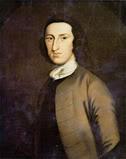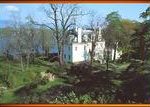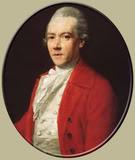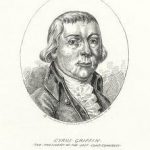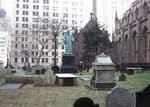Wife of General William Alexander
Image: Lady Stirling
Sarah Livingston Alexander
Sarah Livingston was born in October 1725, the daughter of Philip and Catharine Van Brugh Livingston and a member of that prominent Hudson Valley family. Her brother Philip was a signer of the Declaration of Independence, and her brother William was Governor of New Jersey.
William Alexander was born in 1726 in New York City. His father, James Alexander, was a Jacobite who emigrated to America in 1715. William received an excellent education, and was especially proficient in mathematics and astronomy. He became a lawyer, and held various public offices.
Sarah Livingston married William Alexander on March 1, 1748, and they had two daughters – Mary and Catharine (Kitty).
After his father died, in 1756, William engaged with his widowed mother as a merchant in New York, and later became a commissary for the British army in the French and Indian War. He served as aide-de-camp and secretary to Governor William Shirley, and when the latter was being tried for dereliction of duty, William Alexander traveled to London to testify on Shirley’s behalf in 1756.
The Earl of Stirling
In 1757, William and his family believed that, as senior male descendant of the first earl’s grandfather, he was the rightful heir to the estate of the Earl of Stirling. Stirling is part of Scotland, and it had been given to one of his relatives in 1603 for service to the then king, George II. The issue of importance here is that the king also gave the new Earl possession of half of Long Island, and all of Maine, New Brunswick, Nova Scotia, and Newfoundland, which were immensely valuable.
William spent the next four years in Great Britain chasing this inheritance by gaining the recognition of first the family in Scotland, then the Scottish courts and parliament. He lived in London among the leaders of society as he lobbied Parliament for recognition of his claim. Eventually, at the cost of much of his fortune, he realized that his efforts would be futile. There was little chance that the King or Parliament would give away so valuable a prize, no matter how valid his claim might be. But he continued to call himself Lord Stirling all his life.
William Alexander returned to New York in 1761, after a voyage of three months. He was allowed his title in America by courtesy. In Timothy Trueman’s Almanac for the year 1776, printed by Isaac Collins, of Burlington, his name is given among the members of his majesty’s council of New Jersey as The Honorable Lord Stirling. General George Washington in his correspondence invariably addressed him as my lord.
Lord Stirling immediately assumed a prominent part in colonial affairs. He was appointed Surveyor-General of the Province of New Jersey, and was a member of the Provincial Council. He was one of the founders of King’s College (predecessor of Columbia University), and became its first governor.
Basking Ridge Estate
Soon after his return to this country, Stirling closed his mercantile business, and began building a summer residence on the estate at Basking Ridge, New Jersey. This tract of about 700 acres was inherited from his father, James Alexander. The most skilled gardeners in America were hired to design and lay out the immense park, containing an enclosure for deer, a rose-garden, an Italian vineyard, and other accessories.
The estate was chiefly meadowland, but a gently sloping knoll near the center of the tract furnished a beautiful site for the stately residence he erected there. It was known as The Buildings, and this large dwelling, together with its connecting offices, stables, and coach-houses, were ornamented with cupolas and gilded vanes, and surrounded a paved court or quadrangle. There was a grand hall, and an imposing drawing-room, with richly decorated walls and stucco ceilings.
In 1768, Stirling sold his home in New York, and retired with his family to the Basking Ridge estate. His wife, Lady Sarah, and two daughters, Lady Mary and Lady Kitty, were the admiration of the surrounding country. During the early years of the war, his manor house among the hills of Basking Ridge was still a center of social activity.
The improvement of his estate and his public duties as Surveyor-General of New Jersey and Member of the Provincial Council, occupied his energies until the American Revolution. At the first sign of the severance of the relations between the colonies and the British government, Lord Stirling ardently embraced the cause of liberty. He became a personal friend of General Washington, who placed the utmost confidence in his ability and integrity.

Image: Lord Stirling
William Alexander
Here this American nobleman lived the life of a gentleman of fortune; he rode a great coach with gilded panels, emblazoned with coronets and medallions. Lord Stirling was so generous to the poor on the outskirts of his estate that they bobbed and curtsied to him whenever he passed in his carriage. He dabbled in mining and agriculture, and lived a life befitting an English Lord.
This was an expensive lifestyle, and by the early 1770s, after spending so much of his inheritance in England trying to claim his lordship, Alexander was bankrupt. Only his position in society had kept him afloat, despite expensive failures in mining operations and a failed sale of lottery tickets for his huge and heavily mortgaged real estate holdings. In the end, only his leadership in the Revolutionary army kept him out of jail.
When the Revolutionary War began, William Alexander organized the first two regiments of militia raised in New Jersey, and those who were unable to do otherwise, he equipped at his own expense. He was always willing to spend his own money in support of the cause. Congress commissioned him a colonel in the New Jersey militia on November 7, 1775, and appointed to command the First New Jersey Regiment.
Alexander was soldierly in bearing; according to one writer, “of the most martial appearance of any general in the army save Washington himself.” He was brave, intelligent, energetic and yet cautious; a good organizer and military engineer; “a great acquisition to the army,” in the words of a contemporary.
In January 1776, with forty volunteers in a pilot boat, Alexander captured the armed British transport, Blue Mountain Valley, near Sandy Hook, which was laden with stores and provisions for the British troops at Boston, and carried it into the port at Perth Amboy. For this bold feat, he received the earliest votes thanks of Congress, and on March 1, 1776, the commission of brigadier general in the Continental Army.
The Patriotic Ladies Stirling
In 1776, while William was at White Plains, Sarah joined him in camp. While there, she went to New York – then in possession of the British – with her youngest daughter, Lady Catharine Alexander. They visited the eldest daughter Mary, whose husband, Robert Watts, had remained quietly in the city, taking no active part on either side of the Revolution. The letters of both mother and daughter descriptive of this visit show the situation and temper of those Americans who had remained in the city during its occupation by the enemy.
Lady Catharine wrote about her hope of soon seeing her relatives as zealous patriots as herself. Watts, she says, “is among the number of those who are heartily sick of the tyranny witnessed;” and “as to Mary, her political principles are perfectly rebellious… The sentiments of a great number have undergone a thorough change since they have been with the British army; as they have many opportunities of seeing flagrant acts of injustice and cruelty, of which they could not have believed their friends capable. This convinces them that if they conquer, we must live in abject slavery.”
Lady Stirling exhibited her patriotism when she refused to take advantage of the permission sent from Sir Henry Clinton to take anything she pleased out of the city; fearing “there would be a handle made of it,” if she accepted the offer. “The last time I saw him, he told me I must take a box of tea; but I stuck to my text.”
In February 1777, when General Nathaniel Greene’s division of the Continental Army moved to Basking Ridge, the General’s headquarters were at The Buildings, where he was the guest of Lady Stirling and her daughter, Lady Kitty. The latter was married there to Colonel William Duer in July, 1779, which was remembered as a brilliant social event.
Many exiles from New York and other places had retreated there with their families for safety, and it was naturally the social center of the surrounding country. During the war, Sarah’s brother, Governor William Livingston of New Jersey, moved his family from Elizabethtown to Basking Ridge for safety.
In Defense of New York City
In spring 1776, General Alexander was in charge of the defenses of New York City, and prepared for an imminent British invasion. He was fifty – an old man for that time. Under his direction Forts Lee and Washington were built on opposite sides of the North River above the city. Other fortifications were constructed – nine forts in all, two along the shores of Manhattan, one in what is now Battery Park, and six at various strategic points in Brooklyn.
On June 25, 1776, a British fleet of 130 ships and an army of 9000 arrived in New York Harbor from Halifax, Nova Scotia. In July, the British attempted to contact George Washington to offer terms and forgiveness. Because the British refuse to address him as General, their letters were refused. Later that month, the British forces that had been blockading Charleston arrived, and soon the largest fleet in history, larger than the Spanish Armada, was anchored off Staten Island.
The British hope was to end the American Revolution in a single battle, in which they could bring to bear an overwhelming force and crush the fledgling Continental Army. The largest and best- equipped expeditionary force the British had ever mounted, carried on board the largest armada North America had ever seen, was sent to invade New York, which was judged to be the most important strategic position to occupy.
The British invasion of New York was led by the brothers General William Howe and Admiral Lord Richard Howe. The British force made its initial landing at Staten Island, which was used as the staging ground for the invasion, crossing to Brooklyn on August 22, 1776. Using landing craft built with drop-down bows, the British landed 20,000 troops in four hours. Washington was in Brooklyn on the 24th, examining the ground and the works. When he returned to New York late that afternoon, he gave the command in Brooklyn to General Israel Putnam.
On August 26, General William Howe divided his army, moving a small force of 5000 men under General James Grant along the shore of New York Harbor, and the larger force under General Charles Cornwallis began a flanking expedition that started about 9 pm in the woods of Brooklyn. They marched all night long on a narrow road and through the Jamaica Pass to the east and found it guarded by only a few men, who were easily overpowered.
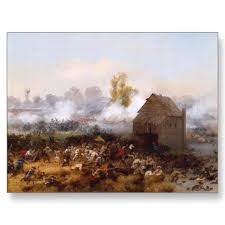
Image: The Battle of Long Island
On the day of the battle (also called the Battle of Brooklyn), August 27, 1776, General Israel Putnam was in overall command of the 10,000 American troops on Long Island. General John Sullivan was in command of the advanced position with 3,500 men on the low hills. General William Alexander was in charge of 1500 troops along the Gowanus Road near the Harbor.
Unfortunately for the Americans, there were only small units at the passes to the east. At Battle Pass, the Americans had chopped down a large oak tree to block the Flatbush Road where it went through the low hills. They were also dug in higher up and flanking the pass. The Hessians (German mercenaries) began a cannonade of the pass defenses at about 1 am.
General Israel Putnam sent 1500 men – two companies from Maryland, two from Delaware, and three from Pennsylvania – under the leadership of Brigadier General William Alexander, Lord Stirling, to oppose the advance of General James Grant on Brooklyn. About 1 am, the British attacked Alexander’s advanced positions, and he moved to reinforce his outposts, stopping the English advance at about 3 am. The Patriots knew nothing of the army in the forest.
As the sun rose on August 27, “17,000 of the best troops of Europe met 5,500 undisciplined men in the first pitched battle of the Revolution,” one observer commented. When General John Sullivan arrived about 8 am, the Germans were still firing their cannon, but the Americans were holding their ground.
The Americans first learned of impending disaster at 9 am, when everyone in the valley heard the bark of a cannon – which announced the arrival of the larger British army in the woods. At the signal, both General Grant and the Hessian mercenaries under General De Heister began to move. The Germans launched an infantry attack on the Americans in the pass, while the British closed in on the rear.
The British forces executed a three-pronged battle plan, engaging the Americans on two fronts, while the largest of the three attacking corps – composed of the most experienced units of the army commanded by General Howe – flanked the American forces from the east. The Americans in the hills along the Gowanus Road were trapped in a vise by the overwhelming combined forces of the British and Hessian soldiers, who were intent on ending the American rebellion and rendering the Declaration of Independence meaningless.
General William Alexander had been ordered by Putnam to repulse the enemy, and for lack of orders to the contrary, he and his men had held on for nearly four hours, but they stayed too long. At eleven am, British General James Grant’s Redcoats hit hard at the center of Alexander’s line, as thousands of Hessians struck from the woods to the left. When he finally pulled back, it was too late.
By 11 am, the Americans near the harbor could hear firing in their rear. In the pass, General John Sullivan’s men were overwhelmed. Many Americans were surrounded in the woods by rings of Hessian troops, who closed in for the kill with bayonets. Some were able to fight their way past the British before the envelopment was completely closed. The fleeing Patriots headed back toward the American lines on Brooklyn Heights. Some tried to surrender, but because of language and cultural differences, many were executed.
More British were coming at him from the rear, on the Gowanus Road, the line of retreat he had been counting on. Realizing that he had been surrounded, Alexander ordered most of his men to fall back in good order, through the marsh and across the creek, while continuing to retard the advance of the British in their front.
The Old Stone House
At mid-day, General Alexander decided to check the British advance by attacking the British at what is now known as the Old Stone House (also known as the Vechte-Cortelyou House). This Dutch farmhouse was built by Nicholas Vechte beside the Gowanus Creek in 1699. Its two-foot-thick wall of fieldstone and brick and its heavily shuttered windows protected the family. The Vechtes prospered, farming the rich bottomland beneath the Heights of Guam and ferrying produce to market in Manhattan.
This house and its strategic position at a crossroads made it the focus of the most dramatic event of the day. Taken in the morning by an estimated 2000 British soldiers, they had occupied the house and turned it into an artillery position to fire on the defeated American soldiers, who were fleeing for their lives.
After Alexander’s main body had escaped by fording Gowanus Creek, he and a contingent of some 400 Maryland Continental soldiers attacked the Redcoats under General Charles Cornwallis, who had established their line on the Gowanus Road beside the stone farmhouse. Into a rain of British fire the Marylanders charged, and Cornwallis recoiled, stunned by the unexpected rebel onslaught.
In a desperate maneuver to enable other American troops to flee to the safety of Washington’s encampment on Brooklyn Heights, with 400 men against 2000, Alexander attacked the British at the Old Stone House. Each attack was met with withering counter fire as the British masses swelled against this fanatically determined American rearguard, but bought precious time for the majority of their comrades to retreat.
Though the ground became littered with dead and dying Maryland militia, Alexander formed the men up again. Again they went forward, closing up the line when comrades fell, reforming and attacking again, their numbers diminishing by the minute. Six times General Alexander charged, and twice the assaults drove the British from the stone house.
As Alexander launched his last assault, with a remaining handful of men, more British reinforcements arrived. At last, the remnant of Marylanders broke into small parties to fight their way to safety. Of the 400 Patriot soldiers, 256 were dead in front of the Old Stone House, and more than a hundred others were killed or captured. Only ten successfully escaped to Brooklyn Heights. But their heroic actions delayed the British, and Howe decided not to attack the Heights that day.
In the last attack, Alexander was captured by some Hessians, but he refused to give up to Cornwallis. He found the Hessian officer, de Heister, and surrendered his sword to him. He had, however, accomplished his objective, which was to facilitate the retreat of the American army. He was put onboard Lord Howe’s flagship. Cornwallis later said, “General Lord Stirling fought like a wolf.”
General Washington had joined his army of 9000 men, and he witnessed the last part of the battle from the fortifications on Brooklyn Heights. He expected Alexander, seeing that resistance was useless, would surrender at once. But when he saw Alexander deliberately sacrifice himself to save the army, he cried, “Good God! what brave fellows I must this day lose!”
“We were on the point of driving Cornwallis from his station,” Alexander wrote after the battle; “but large reinforcements arriving rendered it impossible to provide for more than safety.” He was commended for his bravery by the British as well as by Washington. Several correspondents described him as “the bravest man in America.” Alexander’s bravery that day hardened the resolve of the American Army to continue the fight for freedom.
The Battle of Long Island was the largest battle of the Revolutionary War, and the first fought after the signing of the Declaration of Independence. The American commanders, constantly changing, some in ill health and poorly trained, were not prepared for the feints and maneuvers the British had launched. Far from being aliens in a foreign land, many British officers had spent much of their careers in America, sometimes knowing the ground better than the Patriot generals brought in from other colonies.
Though casualty figures were disputed, the Americans apparently lost about 1,100 men captured, many of them wounded. Estimates are that 300 Americans were killed. Another 100 wounded were evacuated to within the new American lines. The British lost about 370 killed and wounded, plus 23 prisoners who were carried to Brooklyn Heights in the retreat.
While the British had taken the low hills of Brooklyn through superior tactics, they had also begun to realize the terrible truth. It was expensive to take even small pieces of ground from the American army. The Patriots could match the best soldiers in the world for hours, and then retreat to fight another day. The continent was huge and even with a very determined king, there would never be enough time, money, and men to subdue the Patriots.
On August 28, Washington’s officers reported that approximately 1000 American soldiers were killed or captured. The bodies of the dead lay in forests, swamps, and fields; many were buried where they fell. Washington was prepared to defend Brooklyn, but observers reported that the English siege works were coming closer to their own inner line. After a council of war, Washington ordered the evacuation of Brooklyn.
A storm during the day of August 29 hid their preparations. That night under the command of Colonel John Glover, the American army was ferried to Manhattan in anything that could float. Nature granted the retreating Americans the gift of a heavy fog that cloaked their movements. One boatman from a Gloucester, Massachusetts, company was said to have crossed the mile-wide river twenty times.
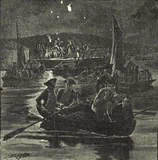
Image: Retreat Across the East River
August 29, 1776
Shortly after dawn on August 30, Hessian patrols reached the Brooklyn ferry in time to see the last of the American soldiers, who had been moved across the mile-wide river in the space of one night. General Washington had left with the last boat.
General Howe arrived at the now-empty American positions at 8:30 am. All that remained were four spiked cannon. The British began to dig trenches, and 25-pound cannons were hauled up the road to begin the siege. The British fleet, with its 26 major battle ships, were prevented from sailing up the East River, because the wind was blowing from the north. If they had been able to bring the fleet up, the entire American army could have been destroyed, which would very likely have been the end of the revolution.
General William Alexander was released in a prisoner exchange a few weeks later. He then rejoined the army in New Jersey, and fought with Washington throughout the balance of war. He was promoted to major general February 19, 1777. Subsequent battles cemented his reputation for bravery and sound tactical judgment. He led a division at the Battle of Brandywine (September 11, 1777), and commanded the reserves under Washington at Germantown. He took over command of West Point after Benedict Arnold turned traitor.
In the melancholy winter of 1777-78 at Valley Forge, he also played a part in exposing the Conway Cabal, a conspiracy of disaffected officers looking to remove Washington as commander of the Continental Army and replace him with General Horatio Gates. Alexander overheard a conversation between the conspirators, and reported their remarks to Washington. It was named after Brigadier General Thomas Conway, whose letters criticizing Washington were forwarded to the Continental Congress. The proposed removal failed when it became public; Conway resigned and General Horatio Gates apologized to Washington.
When Washington led his army south to chase Cornwallis, Alexander was named General of the Army of the North. He was an important second-tier general who was respected and recognized by his peers. His last important battle was at Monmouth (June 28, 1778), where he commanded the left wing. By his brilliant tactics in posting and handling a battery of light artillery, he repelled with heavy loss the enemy’s attempt to turn his flank. In 1778, General Light Horse Harry Lee made his attack on Paulus Hook, and Alexander received the thanks of Congress for the manner in which he had supported Lee’s advance and covered the retreat.
In the record-breaking winter of January 1780, when the bays and sounds near New York were frozen solid, Alexander led an expedition with 2500 men across the ice from Elizabeth, New Jersey, to attack the British position on Staten Island; but the British had received warning, and the enterprise was a failure.
When Washington took his army south in 1781, he appointed Alexander commander of the Northern Department at Albany. Always a heavy drinker, he was in poor health by this time, suffering from severe gout and rheumatism. Among his last military reports was a letter to Governor Clinton (September 10, 1781) giving details of recent events in the Northern Department.
Hearing that the British were advancing by way of Lake George, he went to Saratoga to meet them; but on November 2, 1781, he heard of the surrender of Yorktown, which deterred the British from any further advance. He therefore dismissed the militia and retired to Albany.
General William Alexander, Lord Stirling, died at Albany on January 15, 1783, at the age of 57. His untimely death just months before the official end of the war is the probable reason that he is not as well known today as many other generals. Still, his significant contributions made him one of the most important figures of the American Revolution.
After his death, Lady Stirling received a letter of condolence from General Washington to Lady Stirling, which has been preserved in the Historical Collections of New Jersey:
Newburg, January 20, 1783
My Lady:
Having been informed by letter from Captain Sill of the unspeakable loss which your Ladyship has experienced, I feel the sincerest sympathy those sorrows which I am sensible cannot be removed or effaced. For this purpose, I would also have suggested every rational topic of consolation, were I not fully persuaded that the principles of Philosophy and Religion, of which you are possessed, had anticipated everything I could say on the subject.It only remains, then, as a small but just tribute to the memory of Lord Stirling, to express how deeply I share the common affliction, on being deprived of the public and professional Assistance, as well as the private friendship, of an officer of so high rank, with whom I have lived in the strictest habits of amity; and how much those military merits of his Lordship which rendered him respected in his lifetime, and now regretted by the whole army. It will doubtless be a soothing consideration, in the poignancy of your grief, to find that the general officers are going into mourning for him.
G. Washington
General Alexander’s creditors stripped his mansion and his estates and put Lady Stirling out on the street. She lived out her life in a Manhattan rooming house.
Sarah Livingston Alexander, Lady Stirling, died in March 1805, at the age of 79.
SOURCES
Lady Stirling
Old Stone House
Battle of Brooklyn
The Sterling Manor
Life of Willian Alexander/a>
William Alexander (American general)

